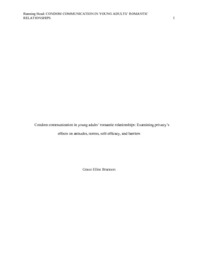
ATTENTION: The works hosted here are being migrated to a new repository that will consolidate resources, improve discoverability, and better show UTA's research impact on the global community. We will update authors as the migration progresses. Please see MavMatrix for more information.
Show simple item record
| dc.contributor.author | Brannon, Grace Ellen, PhD | |
| dc.date.accessioned | 2023-02-13T18:28:18Z | |
| dc.date.available | 2023-02-13T18:28:18Z | |
| dc.date.issued | 2019 | |
| dc.identifier.uri | http://hdl.handle.net/10106/31064 | |
| dc.description.abstract | Condoms are the most recommended method of preventing sexually transmitted infections (STIs), yet they are underutilized. Young adults are at substantially higher risk for contracting an STI than other populations, but do not perceive many sexual behaviors as risky. Research has documented the importance of individuals communicating about STIs and condom usage with romantic partners; unfortunately, these conversations do not occur as they should. This study investigates how young adults in romantic relationships manage privacy processes related to condom communication, using Communication Privacy Management as the theoretical lens. This study seeks to better understand how attitudes, norms, and self-efficacy for communicating about condom use, self-efficacy for buying and using condoms, barriers to condom use, willingness to communicate about health, and health protective sexual communication predict an individual’s boundary permeability and boundary ownership. Both models showed some significant findings. Practical and theoretical implications are discussed. | en_US |
| dc.language.iso | en_US | en_US |
| dc.title | Condom communication in young adults’ romantic relationships: Examining privacy’s effects on attitudes, norms, self-efficacy, and barriers | en_US |
| dc.type | Other | en_US |
Files in this item
- Name:
- Condom communication in young ...
- Size:
- 333.9Kb
- Format:
- PDF
- Description:
- Condom communication in young ...
This item appears in the following Collection(s)
Show simple item record


